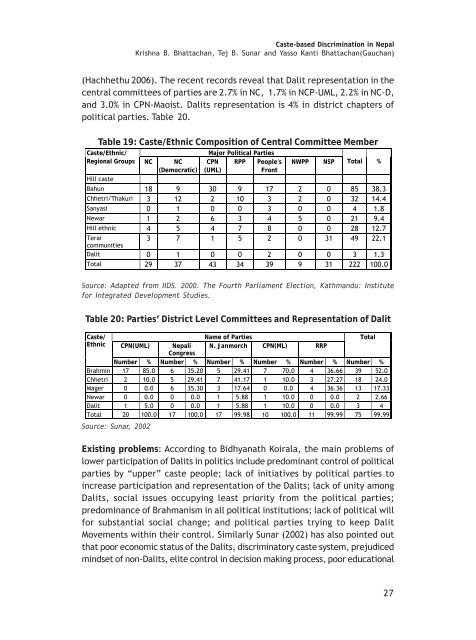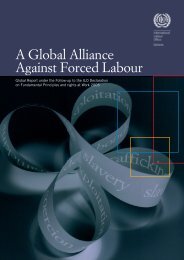Caste-based discrimination in Nepal - International Dalit Solidarity ...
Caste-based discrimination in Nepal - International Dalit Solidarity ...
Caste-based discrimination in Nepal - International Dalit Solidarity ...
You also want an ePaper? Increase the reach of your titles
YUMPU automatically turns print PDFs into web optimized ePapers that Google loves.
<strong>Caste</strong>-<strong>based</strong> Discrim<strong>in</strong>ation <strong>in</strong> <strong>Nepal</strong><br />
Krishna B. Bhattachan, Tej B. Sunar and Yasso Kanti Bhattachan(Gauchan)<br />
(Hachhethu 2006). The recent records reveal that <strong>Dalit</strong> representation <strong>in</strong> the<br />
central committees of parties are 2.7% <strong>in</strong> NC, 1.7% <strong>in</strong> NCP-UML, 2.2% <strong>in</strong> NC-D,<br />
and 3.0% <strong>in</strong> CPN-Maoist. <strong>Dalit</strong>s representation is 4% <strong>in</strong> district chapters of<br />
political parties. Table 20.<br />
Table 19: <strong>Caste</strong>/Ethnic Composition of Central Committee Member<br />
<strong>Caste</strong>/Ethnic/<br />
Regional Groups NC NC<br />
(Democratic)<br />
Hill caste<br />
Major Political Parties<br />
CPN RPP People's<br />
(UML)<br />
Front<br />
NWPP NSP Total %<br />
Bahun 18 9 30 9 17 2 0 85 38.3<br />
Chhetri/Thakuri 3 12 2 10 3 2 0 32 14.4<br />
Sanyasi 0 1 0 0 3 0 0 4 1.8<br />
Newar 1 2 6 3 4 5 0 21 9.4<br />
Hill ethnic 4 5 4 7 8 0 0 28 12.7<br />
Terai<br />
3 7 1 5 2 0 31 49 22.1<br />
communities<br />
<strong>Dalit</strong> 0 1 0 0 2 0 0 3 1.3<br />
Total 29 37 43 34 39 9 31 222 100.0<br />
Source: Adapted from IIDS. 2000. The Fourth Parliament Election, Kathmandu: Institute<br />
for Integrated Development Studies.<br />
Table 20: Parties’ District Level Committees and Representation of <strong>Dalit</strong><br />
<strong>Caste</strong>/<br />
Ethnic<br />
Name of Parties<br />
N. Janmorch CPN(ML) RRP<br />
CPN(UML) <strong>Nepal</strong>i<br />
Congress<br />
Number % Number % Number % Number % Number % Number %<br />
Brahm<strong>in</strong> 17 85.0 6 35.20 5 29.41 7 70.0 4 36.66 39 52.0<br />
Chhetri 2 10.0 5 29.41 7 41.17 1 10.0 3 27.27 18 24.0<br />
Mager 0 0.0 6 35.30 3 17.64 0 0.0 4 36.36 13 17.33<br />
Newar 0 0.0 0 0.0 1 5.88 1 10.0 0 0.0 2 2.66<br />
<strong>Dalit</strong> 1 5.0 0 0.0 1 5.88 1 10.0 0 0.0 3 4<br />
Total 20 100.0 17 100.0 17 99.98 10 100.0 11 99.99 75 99.99<br />
Source: Sunar, 2002<br />
Total<br />
Exist<strong>in</strong>g problems: Accord<strong>in</strong>g to Bidhyanath Koirala, the ma<strong>in</strong> problems of<br />
lower participation of <strong>Dalit</strong>s <strong>in</strong> politics <strong>in</strong>clude predom<strong>in</strong>ant control of political<br />
parties by “upper” caste people; lack of <strong>in</strong>itiatives by political parties to<br />
<strong>in</strong>crease participation and representation of the <strong>Dalit</strong>s; lack of unity among<br />
<strong>Dalit</strong>s, social issues occupy<strong>in</strong>g least priority from the political parties;<br />
predom<strong>in</strong>ance of Brahmanism <strong>in</strong> all political <strong>in</strong>stitutions; lack of political will<br />
for substantial social change; and political parties try<strong>in</strong>g to keep <strong>Dalit</strong><br />
Movements with<strong>in</strong> their control. Similarly Sunar (2002) has also po<strong>in</strong>ted out<br />
that poor economic status of the <strong>Dalit</strong>s, discrim<strong>in</strong>atory caste system, prejudiced<br />
m<strong>in</strong>dset of non-<strong>Dalit</strong>s, elite control <strong>in</strong> decision mak<strong>in</strong>g process, poor educational<br />
27

















